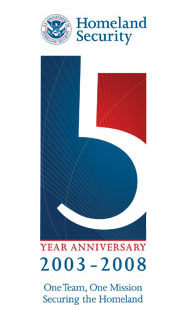
| Home | Information Sharing & Analysis | Prevention & Protection | Preparedness & Response | Research | Commerce & Trade | Travel Security & Procedures | Immigration |
| About the Department | Open for Business | Press Room |

The threat level in the airline sector is High or Orange. Read more.

US-VISIT >> How It Works
In many cases, US-VISIT begins overseas, at the U.S. consular offices issuing visas, where visitors’ biometrics (digital fingerscans and photographs) are collected and checked against a database of known criminals and suspected terrorists. When the visitor arrives at the port of entry, we use the same biometrics – digital fingerscans – to verify the person at our port is the same person who received the visa.
Once at the port of entry you will find that many of the procedures remain unchanged and are familiar to you. For example, a U.S. Customs and Border Protection Officer still reviews your travel documents, such as a visa and passport. The officer still asks you questions about your stay in the U.S.
What’s new under US-VISIT is that the U.S. Customs and Border Protection Officer now uses the inkless, digital fingerscanner to capture two of your fingerscans. You first place your left index finger and then your right index finger on the scanner. The officer also takes your digital photograph. These procedures add only seconds to the overall processing time.
Beginning November 29, 2007, Homeland Security will replace the two-fingerprint scanners with new 10-fingerprint scanners, starting with Washington Dulles International Airport. Read More
Effective May 6, 2007, international travelers are no longer required to check out at a US-VISIT exit kiosk. All other exit procedures remain the same. International travelers who received a CBP Form I-94 (Arrival Departure Record) upon arrival must still return it to an airline or ship representative when departing the United States. Please see press release for more information.
The biographic and biometric data are used to match your identity against the data captured by the State Department at the time the visa was issued to ensure that you are the same person who received the visa. In addition, your digital picture that was taken at the visa-issuing point is displayed to the U.S. Customs and Border Protection Officer for visual comparison and confirmation.
Using all these tools, the U.S. Customs and Border Protection Officer will then either admit you or conduct additional inquiries based on the verification results. These procedures reduce fraud, identity theft, and the risk that terrorists and criminals will enter the U.S. undetected or by using stolen or fraudulent documents.
Download Plug-in
Some of the links on this page require a plug-in to view them. Links to the plug-ins are available below.
This page was last modified on November 13, 2007